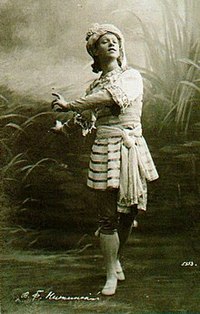
Abstract from Wikipedia : Vaslav Nijinsky (also Vatslav; Russian: Ва́цлав Фоми́ч Нижи́нский; Russian pronunciation: [ˈvatsləf fəˈmʲitɕ nʲɪˈʐɨnskʲɪj]; Polish: Wacław Niżyński; 12 March 1889/1890 – 8 April 1950) was a Russian ballet dancer and choreographer of Polish descent, cited as the greatest male dancer of the early 20th century. He was celebrated for his virtuosity and for the depth and intensity of his characterizations. He could dance en pointe, a rare skill among male dancers at the time and was admired for his seemingly gravity-defying leaps.Nijinsky was introduced to dance by his parents, who were senior dancers with the travelling Setov opera company, and his early childhood was spent touring with the company. His older brother Stanislav Fomitch and younger sister Bronislava Nijinska also became dancers. At age nine Nijinsky was accepted at the Imperial Ballet School (later known as the Maryinsky School) in St. Petersburg, the pre-eminent ballet school in the world. In 1907 he graduated and became a member of the Imperial Ballet, starting at the rank of coryphée instead of in the corps de ballet, already taking starring roles. His sister Bronia also became a dancer and choreographer, working closely with him for much of his career.In 1909 he joined the Ballets Russes, a new ballet company started by Sergei Diaghilev. The impresario took Russian ballets in Paris, where high-quality productions such as those of the Imperial Ballet were not known. Nijinsky became the company's star male dancer, causing an enormous stir amongst audiences whenever he performed. In ordinary life he appeared unremarkable and was withdrawn in conversation. Diaghilev and Nijinsky became lovers; the Ballet Russes gave Nijinsky the chance to expand his art and experiment with dance and choreography; he created new directions for male dancers while becoming internationally famous.In 1912 Nijinsky began choreographing original ballets, including L'après-midi d'un faune (1912) to music by Claude Debussy, Jeux (1913), and Till Eulenspiegel (1916). At the premier of Le Sacre du Printemps (1913) in Paris, with music by Igor Stravinsky, fights broke out in the audience between those who loved and hated this startling new style of ballet and music. Faune caused controversy because of its sexually suggestive final scene. Nijinsky originally conceived Jeux as a flirtatious interaction among three males, although Diaghilev insisted it be danced by one male and two females.In 1913 Nijinsky married Hungarian Romola de Pulszky while on tour with the company in South America. She had 'stalked' the company and Nijinsky since 1912. The marriage caused a break with Diaghilev, who soon dismissed Nijinsky from the company. The couple had two daughters together, Kyra and Tamara Nijinska.With no alternative employer available, Nijinsky tried to form his own company, but this was not a success. He was interned in Budapest, Hungary during World War I, under house arrest until 1916. He was finally permitted to leave after intervention by Diaghilev and international leaders; he was allowed to go to New York for an American tour. Calls for his release had been made by Alfonso XIII of Spain and President President Wilson at the urging of Otto Kahn.Nijinsky became increasingly mentally unstable with the stresses of having to manage tours himself and deprived of opportunities to dance, which had always been his total obsession. After a tour of South America in 1917, and due to travel difficulties imposed by the war, the family settled in St. Moritz, Switzerland. His mental condition deteriorated; he was diagnosed with schizophrenia in 1919 and committed to an asylum for the first time. For the next 30 years, he was in and out of institutions, never dancing again in public.